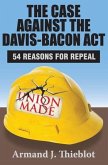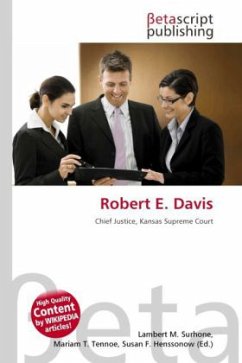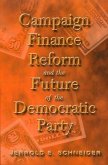- Gebundenes Buch
- Merkliste
- Auf die Merkliste
- Bewerten Bewerten
- Teilen
- Produkt teilen
- Produkterinnerung
- Produkterinnerung
The Davis-Bacon Act is a United States federal law that established the requirement that prevailing wages must be paid on public works projects
Andere Kunden interessierten sich auch für
![The Case Against the Davis-Bacon Act The Case Against the Davis-Bacon Act]() Armand J. ThieblotThe Case Against the Davis-Bacon Act63,99 €
Armand J. ThieblotThe Case Against the Davis-Bacon Act63,99 €![Robert E. Davis Robert E. Davis]() Robert E. Davis26,99 €
Robert E. Davis26,99 €![Leading Works in the History of the Constitution Leading Works in the History of the Constitution]() Leading Works in the History of the Constitution177,99 €
Leading Works in the History of the Constitution177,99 €![Equal Citizenship, Civil Rights, and the Constitution Equal Citizenship, Civil Rights, and the Constitution]() Christopher GreenEqual Citizenship, Civil Rights, and the Constitution185,99 €
Christopher GreenEqual Citizenship, Civil Rights, and the Constitution185,99 €![Religion and the Law Religion and the Law]() Elizabeth EddyReligion and the Law172,99 €
Elizabeth EddyReligion and the Law172,99 €![Campaign Finance Reform and the Future of the Democratic Party Campaign Finance Reform and the Future of the Democratic Party]() Jerrold E. SchneiderCampaign Finance Reform and the Future of the Democratic Party20,99 €
Jerrold E. SchneiderCampaign Finance Reform and the Future of the Democratic Party20,99 €![The European Union as an Area of Freedom, Security and Justice The European Union as an Area of Freedom, Security and Justice]() The European Union as an Area of Freedom, Security and Justice179,99 €
The European Union as an Area of Freedom, Security and Justice179,99 €-
-
-
The Davis-Bacon Act is a United States federal law that established the requirement that prevailing wages must be paid on public works projects
Produktdetails
- Produktdetails
- Verlag: Routledge
- Seitenzahl: 292
- Erscheinungstermin: 20. September 2017
- Englisch
- Abmessung: 235mm x 157mm x 20mm
- Gewicht: 577g
- ISBN-13: 9781138534537
- ISBN-10: 1138534536
- Artikelnr.: 50495251
- Herstellerkennzeichnung
- Libri GmbH
- Europaallee 1
- 36244 Bad Hersfeld
- gpsr@libri.de
- Verlag: Routledge
- Seitenzahl: 292
- Erscheinungstermin: 20. September 2017
- Englisch
- Abmessung: 235mm x 157mm x 20mm
- Gewicht: 577g
- ISBN-13: 9781138534537
- ISBN-10: 1138534536
- Artikelnr.: 50495251
- Herstellerkennzeichnung
- Libri GmbH
- Europaallee 1
- 36244 Bad Hersfeld
- gpsr@libri.de
Armand J. Thieblot
Foreword
Preface
Fifty-four Reasons for Repeal
Chapter I: Introduction
1. Davis-Bacon Act before 1935
2. Economic Claims Supporting Construction Wage Protection
3. Racial Animus, 1931
4. Probable Real Impetus for Davis-Bacon
5. The Central Concept Maintaining the Prevailing Wage
6. The Davis-Bacon Act after 1935
Chapter II: Overview of the Construction Industry and Its Labor Relations
1. Fungible Construction Output
2. Industrial Structure: The Union Pattern
3. Industrial Structure: The Nonunion Pattern
4. Craft Unions in the AFL
5. Semi-Skilled Workers and Helpers
6. Union and Nonunion Wage Rates, and the Union Wage Rate Differential
7. The Total Union Premium
8. Types of Construction Markets
Chapter III: Wage Determination Overview
1. Experience with Wage Determinations
2. Overview of Wage Determinations
3. Anatomy of Wage Survey Process
4. Safe Union Territory
5. Arbitrary Divisions among Work Regimes
6. Specialty Work and Worker Surveys
Chapter IV: The Helper Experiment
1. The Helper Rate Controversy
2. Summary of DOL's Handling of Helper and Helper-Like Rates
3.DOL's Questionable Implementation of Helper Usein Surveys During the
Period of Non-Suspension
4. Summary of the Helper Controversy
Chapter V: Mechanics of Wage Surveys
1.Survey Mechanics
2. DOL's Manipulative Mechanics in Surveys, Illustrated by the 2002
Pittsburgh-area Residential Construction Survey
Chapter VI: Anatomy of a Wage Determination
1. Illustration from a Current Determination
2. Davis-Bacon Fosters Anomalies
3. Implicit Expansions to Unlisted Rates
Chapter VII: Costs, Counterclaims, Compromises, and Conclusions
1. Costs of Davis-Bacon
2. Counterclaims: The Benefits of Davis-Bacon
3. Compromise: Why Solutions Short of Repeal Won't Work
4. Conclusions
Appendix One: The Davis-Bacon Act
Appendix Two: The Construction Industry: Labor Organization and Manpower
Use
Appendix Three: Proliferating Semi-Skilled Job Titles and the Helper
Controversy
Appendix Four: Anomalies in Projects Used by DOL in Conducting Wage Survey
94-MD-022
Appendix Five: Mechanics of Wage Determination:The Pennsylvania Example
Appendix Six: A Few Anomalies from Current Pennsylvania Determinations
Appendix Seven: Excerpts from the Statements of Jeff Lester, Deputy
Commissioner, Oklahoma Department of Labor
Selected Bibliography
Preface
Fifty-four Reasons for Repeal
Chapter I: Introduction
1. Davis-Bacon Act before 1935
2. Economic Claims Supporting Construction Wage Protection
3. Racial Animus, 1931
4. Probable Real Impetus for Davis-Bacon
5. The Central Concept Maintaining the Prevailing Wage
6. The Davis-Bacon Act after 1935
Chapter II: Overview of the Construction Industry and Its Labor Relations
1. Fungible Construction Output
2. Industrial Structure: The Union Pattern
3. Industrial Structure: The Nonunion Pattern
4. Craft Unions in the AFL
5. Semi-Skilled Workers and Helpers
6. Union and Nonunion Wage Rates, and the Union Wage Rate Differential
7. The Total Union Premium
8. Types of Construction Markets
Chapter III: Wage Determination Overview
1. Experience with Wage Determinations
2. Overview of Wage Determinations
3. Anatomy of Wage Survey Process
4. Safe Union Territory
5. Arbitrary Divisions among Work Regimes
6. Specialty Work and Worker Surveys
Chapter IV: The Helper Experiment
1. The Helper Rate Controversy
2. Summary of DOL's Handling of Helper and Helper-Like Rates
3.DOL's Questionable Implementation of Helper Usein Surveys During the
Period of Non-Suspension
4. Summary of the Helper Controversy
Chapter V: Mechanics of Wage Surveys
1.Survey Mechanics
2. DOL's Manipulative Mechanics in Surveys, Illustrated by the 2002
Pittsburgh-area Residential Construction Survey
Chapter VI: Anatomy of a Wage Determination
1. Illustration from a Current Determination
2. Davis-Bacon Fosters Anomalies
3. Implicit Expansions to Unlisted Rates
Chapter VII: Costs, Counterclaims, Compromises, and Conclusions
1. Costs of Davis-Bacon
2. Counterclaims: The Benefits of Davis-Bacon
3. Compromise: Why Solutions Short of Repeal Won't Work
4. Conclusions
Appendix One: The Davis-Bacon Act
Appendix Two: The Construction Industry: Labor Organization and Manpower
Use
Appendix Three: Proliferating Semi-Skilled Job Titles and the Helper
Controversy
Appendix Four: Anomalies in Projects Used by DOL in Conducting Wage Survey
94-MD-022
Appendix Five: Mechanics of Wage Determination:The Pennsylvania Example
Appendix Six: A Few Anomalies from Current Pennsylvania Determinations
Appendix Seven: Excerpts from the Statements of Jeff Lester, Deputy
Commissioner, Oklahoma Department of Labor
Selected Bibliography
Foreword
Preface
Fifty-four Reasons for Repeal
Chapter I: Introduction
1. Davis-Bacon Act before 1935
2. Economic Claims Supporting Construction Wage Protection
3. Racial Animus, 1931
4. Probable Real Impetus for Davis-Bacon
5. The Central Concept Maintaining the Prevailing Wage
6. The Davis-Bacon Act after 1935
Chapter II: Overview of the Construction Industry and Its Labor Relations
1. Fungible Construction Output
2. Industrial Structure: The Union Pattern
3. Industrial Structure: The Nonunion Pattern
4. Craft Unions in the AFL
5. Semi-Skilled Workers and Helpers
6. Union and Nonunion Wage Rates, and the Union Wage Rate Differential
7. The Total Union Premium
8. Types of Construction Markets
Chapter III: Wage Determination Overview
1. Experience with Wage Determinations
2. Overview of Wage Determinations
3. Anatomy of Wage Survey Process
4. Safe Union Territory
5. Arbitrary Divisions among Work Regimes
6. Specialty Work and Worker Surveys
Chapter IV: The Helper Experiment
1. The Helper Rate Controversy
2. Summary of DOL's Handling of Helper and Helper-Like Rates
3.DOL's Questionable Implementation of Helper Usein Surveys During the
Period of Non-Suspension
4. Summary of the Helper Controversy
Chapter V: Mechanics of Wage Surveys
1.Survey Mechanics
2. DOL's Manipulative Mechanics in Surveys, Illustrated by the 2002
Pittsburgh-area Residential Construction Survey
Chapter VI: Anatomy of a Wage Determination
1. Illustration from a Current Determination
2. Davis-Bacon Fosters Anomalies
3. Implicit Expansions to Unlisted Rates
Chapter VII: Costs, Counterclaims, Compromises, and Conclusions
1. Costs of Davis-Bacon
2. Counterclaims: The Benefits of Davis-Bacon
3. Compromise: Why Solutions Short of Repeal Won't Work
4. Conclusions
Appendix One: The Davis-Bacon Act
Appendix Two: The Construction Industry: Labor Organization and Manpower
Use
Appendix Three: Proliferating Semi-Skilled Job Titles and the Helper
Controversy
Appendix Four: Anomalies in Projects Used by DOL in Conducting Wage Survey
94-MD-022
Appendix Five: Mechanics of Wage Determination:The Pennsylvania Example
Appendix Six: A Few Anomalies from Current Pennsylvania Determinations
Appendix Seven: Excerpts from the Statements of Jeff Lester, Deputy
Commissioner, Oklahoma Department of Labor
Selected Bibliography
Preface
Fifty-four Reasons for Repeal
Chapter I: Introduction
1. Davis-Bacon Act before 1935
2. Economic Claims Supporting Construction Wage Protection
3. Racial Animus, 1931
4. Probable Real Impetus for Davis-Bacon
5. The Central Concept Maintaining the Prevailing Wage
6. The Davis-Bacon Act after 1935
Chapter II: Overview of the Construction Industry and Its Labor Relations
1. Fungible Construction Output
2. Industrial Structure: The Union Pattern
3. Industrial Structure: The Nonunion Pattern
4. Craft Unions in the AFL
5. Semi-Skilled Workers and Helpers
6. Union and Nonunion Wage Rates, and the Union Wage Rate Differential
7. The Total Union Premium
8. Types of Construction Markets
Chapter III: Wage Determination Overview
1. Experience with Wage Determinations
2. Overview of Wage Determinations
3. Anatomy of Wage Survey Process
4. Safe Union Territory
5. Arbitrary Divisions among Work Regimes
6. Specialty Work and Worker Surveys
Chapter IV: The Helper Experiment
1. The Helper Rate Controversy
2. Summary of DOL's Handling of Helper and Helper-Like Rates
3.DOL's Questionable Implementation of Helper Usein Surveys During the
Period of Non-Suspension
4. Summary of the Helper Controversy
Chapter V: Mechanics of Wage Surveys
1.Survey Mechanics
2. DOL's Manipulative Mechanics in Surveys, Illustrated by the 2002
Pittsburgh-area Residential Construction Survey
Chapter VI: Anatomy of a Wage Determination
1. Illustration from a Current Determination
2. Davis-Bacon Fosters Anomalies
3. Implicit Expansions to Unlisted Rates
Chapter VII: Costs, Counterclaims, Compromises, and Conclusions
1. Costs of Davis-Bacon
2. Counterclaims: The Benefits of Davis-Bacon
3. Compromise: Why Solutions Short of Repeal Won't Work
4. Conclusions
Appendix One: The Davis-Bacon Act
Appendix Two: The Construction Industry: Labor Organization and Manpower
Use
Appendix Three: Proliferating Semi-Skilled Job Titles and the Helper
Controversy
Appendix Four: Anomalies in Projects Used by DOL in Conducting Wage Survey
94-MD-022
Appendix Five: Mechanics of Wage Determination:The Pennsylvania Example
Appendix Six: A Few Anomalies from Current Pennsylvania Determinations
Appendix Seven: Excerpts from the Statements of Jeff Lester, Deputy
Commissioner, Oklahoma Department of Labor
Selected Bibliography









